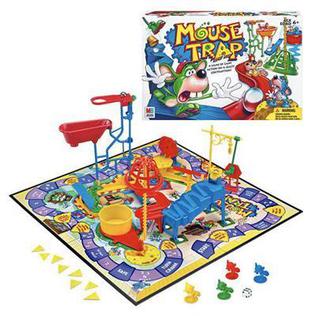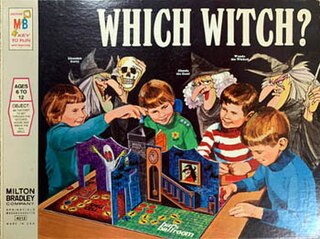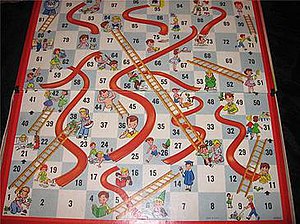
Ludo is a strategy board game for two to four players, in which the players race their four tokens from start to finish according to the rolls of a single die. Like other cross and circle games, Ludo is derived from the Indian game Pachisi. The game and its variations are popular in many countries and under various names.

Scotland Yard is a board game in which a team of players controlling different detectives cooperate to track down a player controlling a criminal as they move around a board representing the streets of London. It was first published in 1983. It is named after Scotland Yard which is the headquarters of London's Metropolitan Police Service in real-life. Scotland Yard is an asymmetric board game, during which the detective players cooperatively solve a variant of the pursuit–evasion problem. The game is published by Ravensburger in most of Europe and Canada and by Milton Bradley in the United States. It received the Spiel des Jahres award in 1983-the same year that it was published.

Milton Bradley Company or simply Milton Bradley (MB) was an American board game manufacturer established by Milton Bradley (1836-1911) in Springfield, Massachusetts, in 1860. In 1920, it absorbed the game production of McLoughlin Brothers, formerly the largest game manufacturer in the United States. It was acquired by Hasbro in 1984, and merged with their subsidiary Parker Brothers in 1998. The brand name continued to be used by Hasbro until 2009.

Candy Land is a simple racing board game created by Eleanor Abbott and published by Milton Bradley in 1948. The game requires no reading and minimal counting skills, making it suitable for young children. No strategy is involved as players are never required to make choices; only following directions is required. About one million copies per year are sold.

Trouble is a board game in which players compete to be the first to send four pieces all the way around a board. It is based on a traditional game called "Frustration" played on a wooden board with indentations for marble playing pieces and rules similar to Parcheesi. Pieces are moved according to the roll of a die using a contained device called a "Pop-O-Matic".

Battleship is a strategy type guessing game for two players. It is played on ruled grids on which each player's fleet of warships are marked. The locations of the fleets are concealed from the other player. Players alternate turns calling "shots" at the other player's ships, and the objective of the game is to destroy the opposing player's fleet.

Parcheesi is a brand-name American adaptation of the Indian cross and circle board game Pachisi, published by Selchow & Righter and Winning Moves Games USA.

Chaupar, chopad or chaupad is a cross and circle board game very similar to pachisi, played in India. The board is made of wool or cloth, with wooden pawns and seven cowry shells to be used to determine each player's move, although others distinguish chaupur from pachisi by the use of three four-sided long dice. Variations are played throughout India. It is similar in some ways to Pachisi, Parcheesi and Ludo. In most of the villages of India, this game is played by old people.

Mouse Trap is a board game first published by Ideal in 1963 for two to four players. It is one of the first mass-produced three-dimensional board games. Players at first cooperate to build a working mouse trap in the style of a Rube Goldberg machine. Then, players turn against each other to trap opponents' mouse-shaped game pieces.

Space Crusade is an adventure board game produced by Milton Bradley together with Games Workshop and was first made in 1990. It was produced in the UK and available in some other countries including Finland, Ireland, France, Spain, Denmark, Australia, Hellas and New Zealand. In Germany, Italy, Belgium and the Netherlands, it is known as Star Quest.

Video Village is an American television game show produced by Heatter-Quigley Productions, which aired on the CBS network in daytime from July 11, 1960, to June 15, 1962, and in primetime from July 1 to September 16, 1960. It was notable for the use of its unique "living board game" concept and for premiering soon after the quiz show scandals.

Chowka Bara or Ashta Chamma is a two- or four-player board game from India. This game is an example of a “fully observable” system that has an element of chance introduced by the roll of special dice and an element of strategy. While traditionally played with 4 or 6 cowry shells, dice can also be used.

Which Witch? is a children's board game published in 1970 by the Milton Bradley Company, and was invented by Joseph M. Burck of Marvin Glass and Associates. The board represents a haunted house with four large rooms: the Broom Room, the Witchin' Kitchen, the Spell Cell and the Bat's Ballroom, assembled before play into a three-dimensional model house with vertical walls, and a large plastic chimney in the center. There are four tokens, colored red, yellow, blue and green. Each token is shaped like a child, either a boy or a girl, with four corresponding mouse tokens of identical color.

Milton Bradley was an American business magnate, game pioneer and publisher, credited by many with launching the board game industry, with his eponymous enterprise, which was purchased by Hasbro in 1984, and folded in 1998.

The Game of Life, also known simply as Life, is a board game originally created in 1860 by Milton Bradley as The Checkered Game for Life, the first ever board game for his own company, the Milton Bradley Company. The Game of Life was US's first popular parlour game. The game simulates a person's travels through their life, from early adulthood to retirement, with college if necessary, jobs, marriage, and possible children along the way. Up to six players, depending on the version, can participate in a single game. Variations of the game accommodate up to ten players.

The history of games dates to the ancient human past. Games are an integral part of all cultures and are one of the oldest forms of human social interaction. Games are formalized expressions of play which allow people to go beyond immediate imagination and direct physical activity. Common features of games include uncertainty of outcome, agreed upon rules, competition, separate place and time, elements of fiction, elements of chance, prescribed goals and personal enjoyment.
Elefun is a 1993 children's game from Hasbro. Players use a net to catch butterflies from a plastic elephant's 1-metre-long (3.3 ft) trunk, a plastic chute through which the paper butterflies travel, propelled up by a motor in the elephant. The game was republished twice between 2003 and 2009, starting with the marketing under its "Elefun and Friends" name. This consists of Hungry Hungry Hippos, Mouse Trap, Chasing Cheeky, and Gator Golf.

Gyan Chauper is a dice game derived from chaupar, a board game played in ancient India, popularly known as Snakes and ladders. It was from India that it spread to the rest of the world. It was a very popular game that was played not only for entertainment but also as a way to instruct on morality. The central concept of the game is the liberation from bondage of passions. So the players move from the lower levels of consciousness to higher levels of spiritual enlightenment and finally to Moksha.

An Amerigame, short for American-style board game, is a loose category of tabletop game that generally features a prominent theme, encourages direct conflict between players, and has a significant degree of luck. It is distinguished from a Eurogame, or German-style board game, in that American-style games often have longer playtimes and mechanics designed to suit the theme. Games of this genre are sometimes, if pejoratively, nicknamed Ameritrash.
Andrew S. Topsfield is Keeper of Eastern Art at the Ashmolean Museum, Oxford. He was educated at Winchester College and the universities of Oxford and London. In 1978 he joined the Indian section of the Victoria and Albert Museum as an assistant keeper and moved to the Ashmolean Museum as assistant keeper of eastern art in 1984.























